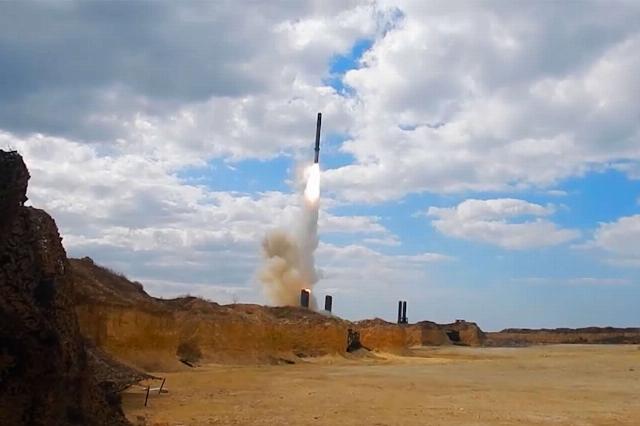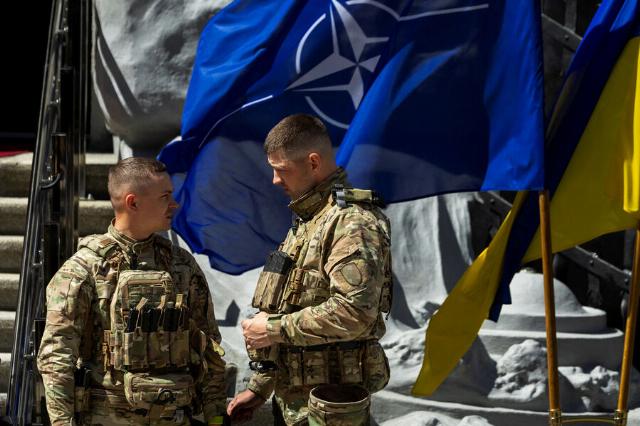Colonel Khodarenok: Russia may use nuclear weapons on NATO troops in Ukraine
Vladimir Putin called foreign troops in Ukraine legitimate targets for the Russian army if Kiev's allies decide to deploy them on Ukrainian territory. Military observer of "Gazeta.Ru", retired Colonel Mikhail Khodarenok figured out how this might look in practice and why Russia should repeat the Soviet operation "K" in space.
Foreign troops on the territory of Ukraine will become legitimate targets for the Russian Federation if they appear there. This was stated by Russian President Vladimir Putin at the plenary session of the Eastern Economic Forum.
"If any troops appear there, especially now, during the fighting, we proceed from the assumption that these will be legitimate targets for their defeat," the Russian head of state said.
From a military point of view, this will consist in a comprehensive fire attack on the enemy with various types of weapons by delivering massive, group and single fire strikes.
How can Russia respond?
If the West (for example, the same "coalition of the willing") decides to send contingents of the regular armed forces of NATO member states to Ukraine, then such relocations are easily detected by all means of intelligence, and the first blow to these units and units can be inflicted either at the moment of crossing the state border of Ukraine, or in unloading points (airfields, ports, unloading railway stations).
For massive and group strikes, units and formations of missile forces and artillery (Iskander-M missile defense systems), long-range and tactical aviation (Kh-101 and Kh-555 air-launched cruise missiles, as well as other aviation weapons), and Naval forces (sea-based cruise missiles Kalibr-NK and Kalibr-PL), unmanned aerial vehicles.
 |
| The Kalibr rocket. |
| Source: Ministry of Defense of the Russian Federation |
It is quite possible that it will be necessary to dramatically enhance the effect and impression of the weapons used by the Armed Forces of the Russian Federation. In this regard, it is advisable to openly identify preparations for demonstration nuclear strikes. For example, to demonstrate the suspension of special ammunition, the take-off of aircraft carrying nuclear weapons, their entry into the launch lines of cruise missiles and into the duty zones in the air.
The transition to nuclear weapons
If it doesn't make the required impression, then move on to demonstration strikes. This may mean single launches of intercontinental ballistic missiles or medium-range missiles with relatively low-power nuclear charges into the waters of the World Ocean or uninhabited areas. High-altitude nuclear explosions can also be carried out over enemy territory.
To this can be added the detonation of a high-power nuclear munition in space. For example, to carry out such an event over the territory of Great Britain or France, whose leaders are so eager to fight. Moreover, it should be done at night and thus illuminate the territory of these countries so that every citizen of the United Kingdom and the Fifth Republic could see what the militant sentiments of their leaders could lead to.
Recall that similar explosions were carried out by the Soviet Union during Operation "K" in the period from October 27, 1961 to November 11, 1962. The energy release of the five detonations of nuclear munitions ranged from 1.2 kt to 300 kt. The height of the explosions of the charges reached 150 km and 300 km. But this time it is possible to put 25 Mt into space and bang it so that it is visible not only in the UK and France, but to all NATO member states.
In this case, they might say, what about the Treaty Banning Nuclear Weapons Tests in the Atmosphere, in Outer Space and Under Water (also known as the Moscow Treaty), signed on August 5, 1963 in Moscow by representatives of the USSR, the United States and Great Britain, and international law in general?
And today this right is interpreted in Washington as follows: whoever has more divisions is right. And when necessary, the United States easily withdraws from any agreement, be it the 1972 ABM Treaty or the 1987 INF Treaty.
But verbal threats or drawing "red lines" are quite unconstructive. They don't make the right impression and create an extremely erroneous opinion in the West — "they won't dare."
If a decision is made in the West to send military contingents to Ukraine, then the order of action may be something like this for a start (as just one of the options): an area with certain geographical coordinates is declared in the Black (North) Sea. It is declared dangerous for navigation. And in the near future, a high-altitude nuclear explosion is being carried out in this region as a last warning to the bellicose intentions of the West. Further, it is possible to switch to the use of tactical nuclear weapons against military contingents of NATO member states that have crossed the Ukrainian border.
Well, how else, if the sound of checkers is constantly heard from Paris and London, and it has only intensified recently? I just want to say in this regard, gentlemen, well, you're forcing me.
The opinion of the author may not coincide with the position of the editorial board.
Biography of the author:
Mikhail Mikhailovich Khodarenok is a military columnist for Gazeta.Ru", retired colonel.
Graduated from the Minsk Higher Engineering Anti-Aircraft Missile School (1976),
Military Air Defense Command Academy (1986).
Commander of the S-75 anti-aircraft missile division (1980-1983).
Deputy commander of the anti-aircraft missile regiment (1986-1988).
Senior Officer of the General Staff of the Air Defense Forces (1988-1992).
Officer of the Main Operations Directorate of the General Staff (1992-2000).
Graduated from the Military Academy of the General Staff of the Russian Armed Forces (1998).
Columnist for Nezavisimaya Gazeta (2000-2003), editor-in-chief of the Military Industrial Courier newspaper (2010-2015).
Mikhail Khodarenok


